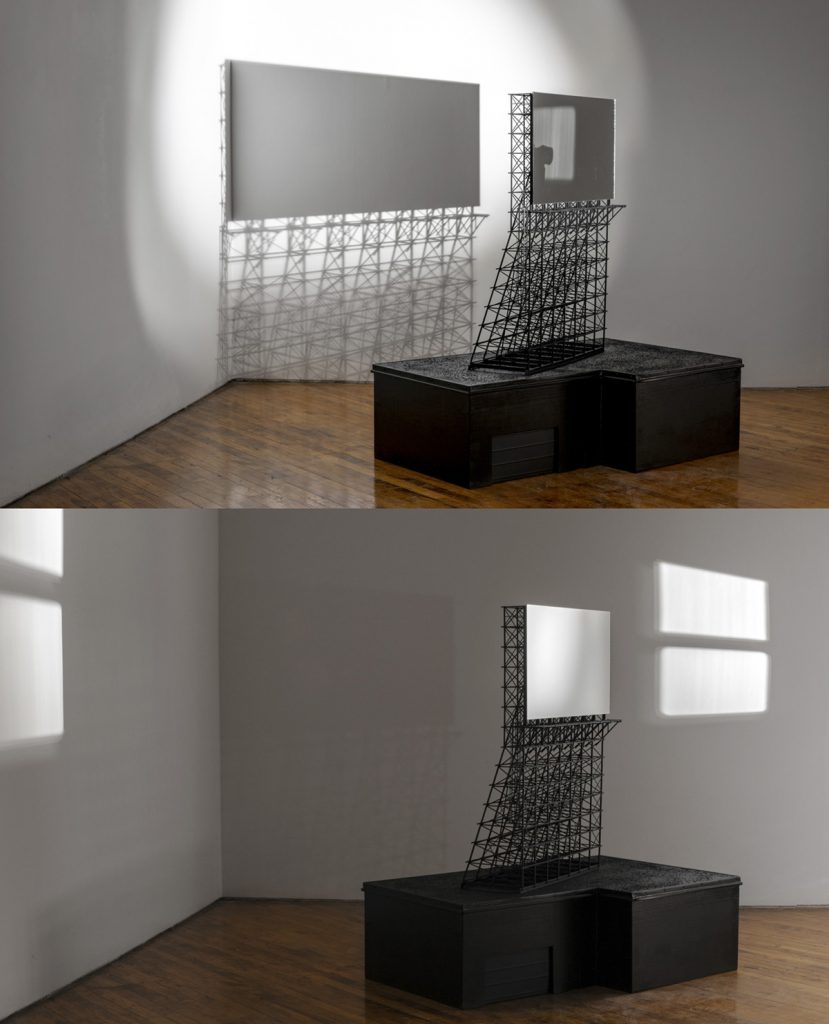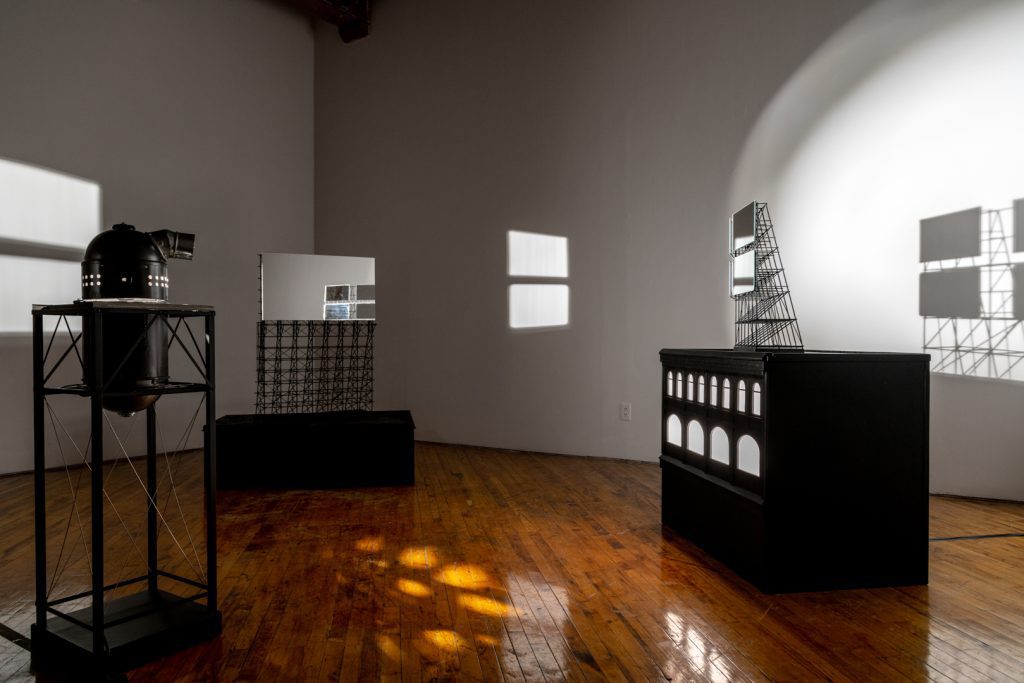Structures for the Expanded Plane at YYZ Artists’ Outlet
17 September 2021
By Casey Hinton
It’s a familiar scene used in countless films: the slow drift of bright car headlights shoot through a window, casting diagonally shifting patterns across a dark interior wall. This haunting cinematic moment was replicated in Chris Foster’s solo exhibition, Structures for the Expanded Plane, at YYZ Artists’ Outlet in Toronto in January 2020. The darkened gallery was lit by a single, waist-high spotlight that rotated with a steady mechanical whir in the centre of the room. There was something strangely familiar, yet unrecognizable, in both the piece’s scale and motion—simultaneously a sun, a clock, a searchlight, a lighthouse, a panopticon—a mechanism for both illuminating and revealing.
Arranged around the mechanical light work were four other large sculptures: 1:12th scale replicas of roadside billboards, resting atop small buildings, presented as matte black monoliths constructed from laser-cut steel. The diminutive size of the billboards recalled high-end train sets or a children’s Meccano kit. Instead of being plastered with advertisements, the billboard’s surfaces were mirrored and reflected the spotlight’s central beam. With each full rotation of the spotlight taking roughly two minutes, the slow pace of the light compels the viewer to spend time with the work. The spotlight activated these static objects, putting them in metaphoric motion as they transmitted light, as if in communication with one another. The reflecting and refracting light drifting across the walls seemed to physically expand the works, filling the room with their presence.
The exhibition’s title points to an expanded projection plane, reminiscent of devices used for translating three-dimensional space onto a two-dimensional plane. The Camera Lucida is one such device; an optical tool and an early precursor to the microscope, which allows a viewer to see both an object and a drawing surface in a single field of view. Structures for the Expanded Plane gestures toward these technological histories and devices that not only help to observe the world with newfound accuracy, but which also aid artists in reducing the scale of their subjects from life-size down to the picture plane.1
The lineage of light technology and the reference to the expanded plane speaks to scale, but also reproduction—the giant billboards are first duplicated in miniature, and again in reflection, then yet again in a shadow. Though billboards traditionally share static points of view—a commercial message communicated to the masses—the “empty” message in Foster’s work is repeated and amplified, framing and reflecting their surroundings, rather than interrupting a view. With no object to be commodified, and therefore no obvious commercial bias, Foster’s billboards serve as both figurative and functional elements in the exhibition: sculpture and armature, frame and image. Their original literal communicative powers have been deconstructed by the mirrors, rendered absurd, and are instead brought back to life through a slow dance of light and shadow.

This translation of scale also puts Foster’s sculptures in direct dialogue with standard bodily scale. The viewer’s body becomes cropped in the reflection of the small mirrors, thus stripping the reflection of its honesty. This newly fragmented image leaves one searching across each sculpture for a full picture of oneself, or seeking to avoid being captured at all. This hunt, mirrored in the actions of the circulating spotlight, endlessly scanning the room, reveals the palpable threat of constant surveillance. The viewer was stalked and observed, yet never fully seen, nor captured. Though these billboards are relics of old world media, with no products to peddle and no point-of-view to declare, here they are given the power to watch, compelling the viewer to engage in what feels like a game of cat-and-mouse. Forced to dodge and weave, the viewer explores the installation discovering moments of privacy in the form of blind spots, free of mirrors or shadows, escaping this unsuspecting but all encompassing surveillance.
The power structures exposed in the built landscape points to moments of tension and absurdity, as the viewer’s presence is amplified and duplicated beyond their control. Though the billboards are without an obvious message, their power to modify and control, much like the advertisements that may have once lived in their frames, is maintained. Presented as high-brow works of art, in contrast to their origins as old-school and low-brow tools of mass communication, responds to the cultural zeitgeist and the marriage of mass surveillance and advertising. Viewers become the message, reflected in the mirrored surfaces, as well as the masses, acting as both the hunter and the hunted—subject and object. In his work, Foster has turned these banal and often overlooked architectural relics, familiar and unfamiliar in their scale, into tools to visualize and give shape to ideas that often go unseen: the surveillance leveraged against us, manipulating our movements and controlling our behaviour.
Structures for the Expanded Plane by Chris Foster ran from January 18 – March 14, 2020 at YYZ Artists’ Outlet in Toronto.
Feature Image: Installation view of Structures for the Expanded Plane by Chris Foster. Photo courtesy of the artist.



